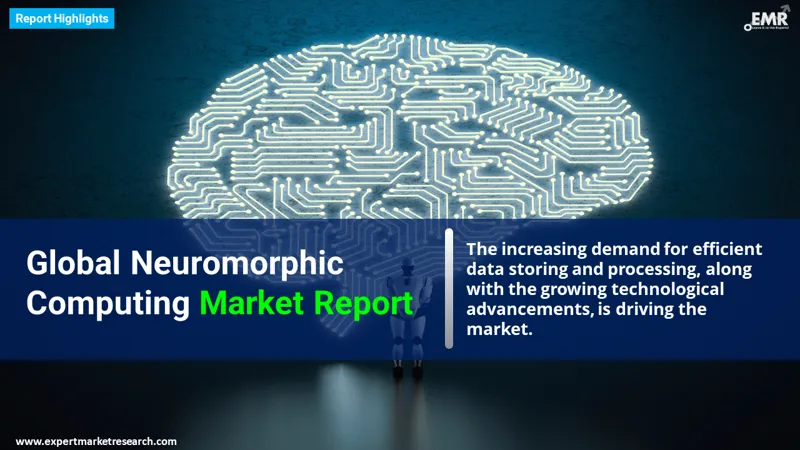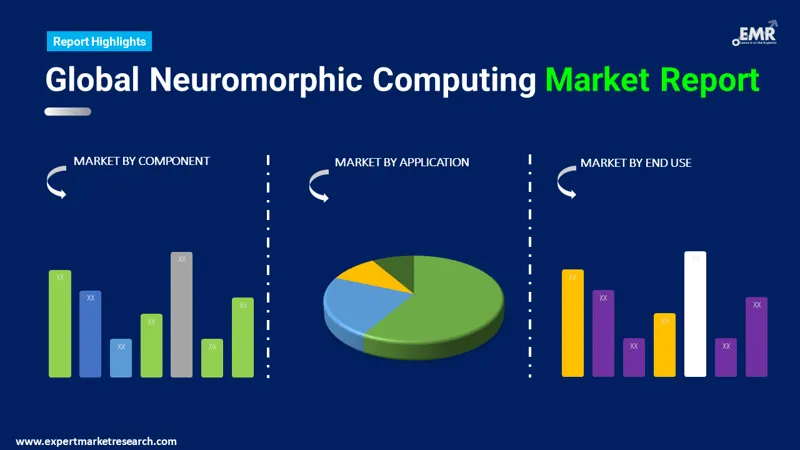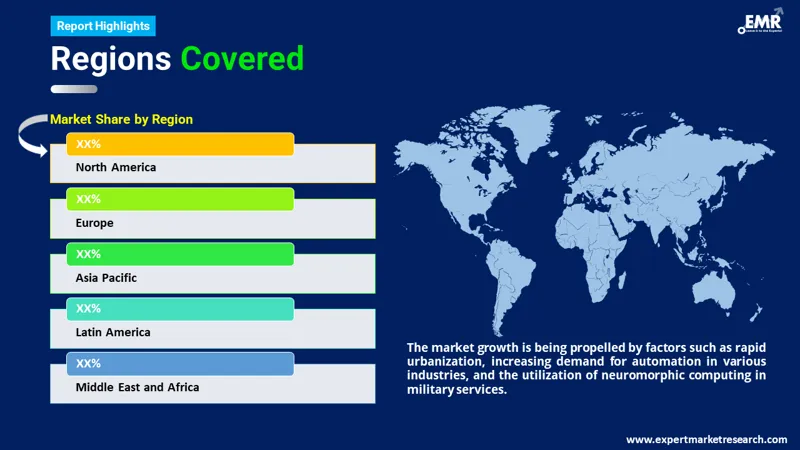Reports
Sale

Global Neuromorphic Computing Market Size, Share, Trends: By Component: Hardware, Software; By Application: Signal Processing, Image Processing, Data Processing, Object Detection, Others; By End Use: Consumer Electronics, Automotive, Healthcare, Military and Defence, Others; Regional Analysis; Competitive Landscape; 2024-2032
Global Neuromorphic Computing Market Outlook
The global neuromorphic computing market is expected to grow in the forecast period of 2024-2032 at a CAGR of 20% to reach nearly USD 23.95 billion by 2032.

Read more about this report - REQUEST FREE SAMPLE COPY IN PDF
Increasing Automation Systems Boosting the Growth of Neuromorphic Industry
The increasing demand for autonomous systems, which are capable of making a suitable decision, is aiding the neuromorphic computing industry. Neuromorphic computing systems need lower power consumption while supporting dynamic learning of complex and unstructured data. Moreover, neuromorphic computing is used to analyse the data produced from climate models, predict maintenance needs for accelerator magnets, and recognising features in large-scale cosmology data. The rising demand for artificial intelligence in nonlinear control and robotics, language processing, image processing, and computer vision, among others, is also contributing to the market growth for neuromorphic computing.
The increasing demand for data and data analytics, miniaturisation of sensors, and cost-effectiveness are further accelerating the market growth. Moreover, neuromorphic computing is increasingly used in the military to collect and process large-sized data efficiently. It is further applicable for the development of cognitive communication system and image processing of unmanned vehicles. Regionally, North America holds the major share of the market for neuromorphic computing owing to the dominant presence of the leading companies and the various initiatives undertaken by them to promote its use in large-scale applications like data centres and server, among others. The Asia Pacific region is expected to witness robust growth due to the rising automated services and increasing technological advancements in countries such as South Korea and Japan, consequently contributing to the overall growth of the market.
Neuromorphic Computing Market Segmentation
Neuromorphic computing, variously known as neuromorphic engineering, is the use of very large scale integration systems containing electronic analogue circuits to model the neuro-biological architects present in the human nervous system. It applies the functionality of a brain to generic cognitive computing and has various advantages, such as energy efficiency and high execution speed.

Read more about this report - REQUEST FREE SAMPLE COPY IN PDF
The major components of neuromorphic computing are:
- Hardware
- Software
The market can be broadly categorised on the basis of its applications into:
- Signal Processing
- Image Processing
- Data Processing
- Object Detection
- Others
Based on the end use, the market is divided into:
- Consumer Electronics
- Automotive
- Healthcare
- Military and Defence
- Others
The EMR report looks into the regional markets of neuromorphic computing like North America, Europe, the Asia Pacific, Latin America, and the Middle East and Africa.
Rising Technological Advancement to Bolster the Growth of Neuromorphic Computing Industry
Various technological advancements such as edge computing and the Internet of things (IoT) are increasingly used in several industries and businesses. With the increasing digitisation, technologies such as drones, smart healthcare, smart cities, and autonomous cars are becoming more prevalent and hence are increasing the demand for neuromorphic computing chips, which can combat the challenge of increasing data and processing. Moreover, increasing research and development (R&D) in the field of both neurology and computing are expected to aid the market growth. The development of neuromorphic chips which functions like a human brain by using artificial neurons is further propelling the market growth. Additionally, neuromorphic computing can create cognitive computing and systems which can reason or learn like a human.
Neuromorphic computing can further improve therapeutic procedures, develop more precise medical imaging, enhance surveillance, improve data mining and pattern recognition systems, and assist in military and security issue which is expected to augment the industry growth in the forecast period. The use of neuromorphic computing in automated vehicles can reduce latency, increase energy costs, and increase the autonomy of the vehicle while improving cybersecurity, consequently lubricating the market growth. The increasing research for neuromorphic computing to improve machine learning, remote sensing, and intelligence analysis is further driving the market. In addition, favourable government schemes and investments are also fuelling the market growth. For example, the U.S. Department of Energy (DOE) announced $2million in funding for five projects in basic research to advance neuromorphic computing in September 2020.

Read more about this report - REQUEST FREE SAMPLE COPY IN PDF
Key Industry Players in the Global Neuromorphic Computing Market
The report presents a detailed analysis of the following key players in the global neuromorphic computing market, looking into their capacity, market shares, and latest developments like capacity expansions, plant turnarounds, and mergers and acquisitions:
- Intel Corporation
- BrainChip Holdings Ltd
- General Vision Inc.
- IBM Corporation
- Others
The comprehensive report looks into the macro and micro aspects of the industry. The EMR report gives an in-depth insight into the market by providing a SWOT analysis as well as an analysis of Porter’s Five Forces model.
Key Highlights of the Report
| REPORT FEATURES | DETAILS |
| Base Year | 2023 |
| Historical Period | 2018-2023 |
| Forecast Period | 2024-2032 |
| Scope of the Report |
Historical and Forecast Trends, Industry Drivers and Constraints, Historical and Forecast Market Analysis by Segment:
|
| Breakup by Component |
|
| Breakup by Application |
|
| Breakup by End Use |
|
| Breakup by Region |
|
| Market Dynamics |
|
| Competitive Landscape |
|
| Companies Covered |
|
| Report Price and Purchase Option | Explore our purchase options that are best suited to your resources and industry needs. |
| Delivery Format | Delivered as an attached PDF and Excel through email, with an option of receiving an editable PPT, according to the purchase option. |
*At Expert Market Research, we strive to always give you current and accurate information. The numbers depicted in the description are indicative and may differ from the actual numbers in the final EMR report.
1 Preface
2 Report Coverage – Key Segmentation and Scope
3 Report Description
3.1 Market Definition and Outlook
3.2 Properties and Applications
3.3 Market Analysis
3.4 Key Players
4 Key Assumptions
5 Executive Summary
5.1 Overview
5.2 Key Drivers
5.3 Key Developments
5.4 Competitive Structure
5.5 Key Industrial Trends
6 Snapshot
6.1 Global
6.2 Regional
7 Opportunities and Challenges in the Market
8 Global Neuromorphic Computing Market Analysis
8.1 Key Industry Highlights
8.2 Global Neuromorphic Computing Historical Market (2018-2023)
8.3 Global Neuromorphic Computing Market Forecast (2024-2032)
8.4 Global Neuromorphic Computing Market by Component
8.4.1 Hardware
8.4.1.1 Historical Trend (2018-2023)
8.4.1.2 Forecast Trend (2024-2032)
8.4.2 Software
8.4.2.1 Historical Trend (2018-2023)
8.4.2.2 Forecast Trend (2024-2032)
8.5 Global Neuromorphic Computing Market by Application
8.5.1 Signal Processing
8.5.1.1 Historical Trend (2018-2023)
8.5.1.2 Forecast Trend (2024-2032)
8.5.2 Image Processing
8.5.2.1 Historical Trend (2018-2023)
8.5.2.2 Forecast Trend (2024-2032)
8.5.3 Data Processing
8.5.3.1 Historical Trend (2018-2023)
8.5.3.2 Forecast Trend (2024-2032)
8.5.4 Object Detection
8.5.4.1 Historical Trend (2018-2023)
8.5.4.2 Forecast Trend (2024-2032)
8.5.5 Others
8.6 Global Neuromorphic Computing Market by End Use
8.6.1 Consumer Electronics
8.6.1.1 Historical Trend (2018-2023)
8.6.1.2 Forecast Trend (2024-2032)
8.6.2 Automotive
8.6.2.1 Historical Trend (2018-2023)
8.6.2.2 Forecast Trend (2024-2032)
8.6.3 Healthcare
8.6.3.1 Historical Trend (2018-2023)
8.6.3.2 Forecast Trend (2024-2032)
8.6.4 Military and Defence
8.6.4.1 Historical Trend (2018-2023)
8.6.4.2 Forecast Trend (2024-2032)
8.6.5 Others
8.7 Global Neuromorphic Computing Market by Region
8.7.1 North America
8.7.1.1 Historical Trend (2018-2023)
8.7.1.2 Forecast Trend (2024-2032)
8.7.2 Europe
8.7.2.1 Historical Trend (2018-2023)
8.7.2.2 Forecast Trend (2024-2032)
8.7.3 Asia Pacific
8.7.3.1 Historical Trend (2018-2023)
8.7.3.2 Forecast Trend (2024-2032)
8.7.4 Latin America
8.7.4.1 Historical Trend (2018-2023)
8.7.4.2 Forecast Trend (2024-2032)
8.7.5 Middle East and Africa
8.7.5.1 Historical Trend (2018-2023)
8.7.5.2 Forecast Trend (2024-2032)
9 North America Neuromorphic Computing Market Analysis
9.1 United States of America
9.1.1 Historical Trend (2018-2023)
9.1.2 Forecast Trend (2024-2032)
9.2 Canada
9.2.1 Historical Trend (2018-2023)
9.2.2 Forecast Trend (2024-2032)
10 Europe Neuromorphic Computing Market Analysis
10.1 United Kingdom
10.1.1 Historical Trend (2018-2023)
10.1.2 Forecast Trend (2024-2032)
10.2 Germany
10.2.1 Historical Trend (2018-2023)
10.2.2 Forecast Trend (2024-2032)
10.3 France
10.3.1 Historical Trend (2018-2023)
10.3.2 Forecast Trend (2024-2032)
10.4 Italy
10.4.1 Historical Trend (2018-2023)
10.4.2 Forecast Trend (2024-2032)
10.5 Others
11 Asia Pacific Neuromorphic Computing Market Analysis
11.1 China
11.1.1 Historical Trend (2018-2023)
11.1.2 Forecast Trend (2024-2032)
11.2 Japan
11.2.1 Historical Trend (2018-2023)
11.2.2 Forecast Trend (2024-2032)
11.3 India
11.3.1 Historical Trend (2018-2023)
11.3.2 Forecast Trend (2024-2032)
11.4 ASEAN
11.4.1 Historical Trend (2018-2023)
11.4.2 Forecast Trend (2024-2032)
11.5 Australia
11.5.1 Historical Trend (2018-2023)
11.5.2 Forecast Trend (2024-2032)
11.6 Others
12 Latin America Neuromorphic Computing Market Analysis
12.1 Brazil
12.1.1 Historical Trend (2018-2023)
12.1.2 Forecast Trend (2024-2032)
12.2 Argentina
12.2.1 Historical Trend (2018-2023)
12.2.2 Forecast Trend (2024-2032)
12.3 Mexico
12.3.1 Historical Trend (2018-2023)
12.3.2 Forecast Trend (2024-2032)
12.4 Others
13 Middle East and Africa Neuromorphic Computing Market Analysis
13.1 Saudi Arabia
13.1.1 Historical Trend (2018-2023)
13.1.2 Forecast Trend (2024-2032)
13.2 United Arab Emirates
13.2.1 Historical Trend (2018-2023)
13.2.2 Forecast Trend (2024-2032)
13.3 Nigeria
13.3.1 Historical Trend (2018-2023)
13.3.2 Forecast Trend (2024-2032)
13.4 South Africa
13.4.1 Historical Trend (2018-2023)
13.4.2 Forecast Trend (2024-2032)
13.5 Others
14 Market Dynamics
14.1 SWOT Analysis
14.1.1 Strengths
14.1.2 Weaknesses
14.1.3 Opportunities
14.1.4 Threats
14.2 Porter’s Five Forces Analysis
14.2.1 Supplier’s Power
14.2.2 Buyer’s Power
14.2.3 Threat of New Entrants
14.2.4 Degree of Rivalry
14.2.5 Threat of Substitutes
14.3 Key Indicators for Demand
14.4 Key Indicators for Price
15 Value Chain Analysis
16 Competitive Landscape
16.1 Market Structure
16.2 Company Profiles
16.2.1 Intel Corporation
16.2.1.1 Company Overview
16.2.1.2 Product Portfolio
16.2.1.3 Demographic Reach and Achievements
16.2.1.4 Certifications
16.2.2 BrainChip Holdings Ltd.
16.2.2.1 Company Overview
16.2.2.2 Product Portfolio
16.2.2.3 Demographic Reach and Achievements
16.2.2.4 Certifications
16.2.3 General Vision Inc.
16.2.3.1 Company Overview
16.2.3.2 Product Portfolio
16.2.3.3 Demographic Reach and Achievements
16.2.3.4 Certifications
16.2.4 IBM Corporation
16.2.4.1 Company Overview
16.2.4.2 Product Portfolio
16.2.4.3 Demographic Reach and Achievements
16.2.4.4 Certifications
16.2.5 Others
17 Key Trends and Developments in the Market
List of Key Figures and Tables
1. Global Neuromorphic Computing Market: Key Industry Highlights, 2018 and 2032
2. Global Neuromorphic Computing Historical Market: Breakup by Component (USD Billion), 2018-2023
3. Global Neuromorphic Computing Market Forecast: Breakup by Component (USD Billion), 2024-2032
4. Global Neuromorphic Computing Historical Market: Breakup by Application (USD Billion), 2018-2023
5. Global Neuromorphic Computing Market Forecast: Breakup by Application (USD Billion), 2024-2032
6. Global Neuromorphic Computing Historical Market: Breakup by End Use (USD Billion), 2018-2023
7. Global Neuromorphic Computing Market Forecast: Breakup by End Use (USD Billion), 2024-2032
8. Global Neuromorphic Computing Historical Market: Breakup by Region (USD Billion), 2018-2023
9. Global Neuromorphic Computing Market Forecast: Breakup by Region (USD Billion), 2024-2032
10. North America Neuromorphic Computing Historical Market: Breakup by Country (USD Billion), 2018-2023
11. North America Neuromorphic Computing Market Forecast: Breakup by Country (USD Billion), 2024-2032
12. Europe Neuromorphic Computing Historical Market: Breakup by Country (USD Billion), 2018-2023
13. Europe Neuromorphic Computing Market Forecast: Breakup by Country (USD Billion), 2024-2032
14. Asia Pacific Neuromorphic Computing Historical Market: Breakup by Country (USD Billion), 2018-2023
15. Asia Pacific Neuromorphic Computing Market Forecast: Breakup by Country (USD Billion), 2024-2032
16. Latin America Neuromorphic Computing Historical Market: Breakup by Country (USD Billion), 2018-2023
17. Latin America Neuromorphic Computing Market Forecast: Breakup by Country (USD Billion), 2024-2032
18. Middle East and Africa Neuromorphic Computing Historical Market: Breakup by Country (USD Billion), 2018-2023
19. Middle East and Africa Neuromorphic Computing Market Forecast: Breakup by Country (USD Billion), 2024-2032
20. Global Neuromorphic Computing Market Structure
The global neuromorphic computing market is projected to grow at a CAGR of 20% between 2024 and 2032.
The market is estimated to witness a healthy growth in the forecast period of 2024-2032 to reach nearly USD 23.95 billion by 2032.
The major market drivers include the technological advancements and innovations, increasing demand for autonomous systems, the rising deployment of artificial intelligence (AI), and the surging demand for data and data analytics.
The key trends propelling the market demand include the increasing R&D activities in the field of neurology and computing and the growing use of neuromorphic computing in automated vehicles to reduce latency.
The major regions in the neuromorphic computing market are North America, Latin America, the Middle East and Africa, Europe, and the Asia Pacific.
The major components of neuromorphic computing in the market are hardware and software.
The significant applications of neuromorphic computing are signal processing, image processing, data processing, and object detection, among others.
The various end uses of neuromorphic computing are consumer electronics, automotive, healthcare, and military and defence, among others.
The major players in the market are Intel Corporation, BrainChip Holdings Ltd, General Vision Inc., and IBM Corporation, among others.
The global neuromorphic computing market is driven by the rising demand for automated systems in industries. Aided by the growing technological advancements, the market is expected to witness a further growth in the forecast period of 2024-2032, growing at a CAGR of 20%. The market is projected to reach nearly USD 23.95 billion by 2032.
EMR’s meticulous research methodology delves deep into the market, covering the macro and micro aspects of the industry. Based on its components, the neuromorphic computing industry can be segmented into software and hardware. On the basis of applications, the industry is divided into signal processing, image processing, data processing, and object detection, among others. Based on the end use, the market is segmented into consumer electronics, automotive, healthcare, and military and defence, among others. The major regional markets for neuromorphic computing are North America, Europe, the Asia Pacific, Latin America, and the Middle East and Africa, with North America accounting for the largest share of the market. The key players in the above market include Intel Corporation, BrainChip Holdings Ltd, General Vision Inc., and IBM Corporation, among others.
EMR’s research methodology uses a combination of cutting-edge analytical tools and the expertise of their highly accomplished team, thus, providing their customers with market insights that are accurate, actionable, and help them remain ahead of their competition.
Mini Report
-
Selected Sections, One User
-
Printing Not Allowed
-
Email Delivery in PDF
-
Free Limited Customisation -
Post Sales Analyst Support -
50% Discount on Next Update
Single User License
-
All Sections, One User
-
One Print Allowed
-
Email Delivery in PDF
-
Free Limited Customisation -
Post Sales Analyst Support -
50% Discount on Next Update

Five User License
-
All Sections, Five Users
-
Five Prints Allowed
-
Email Delivery in PDF
-
Free Limited Customisation
-
Post Sales Analyst Support
-
50% Discount on Next Update
Corporate License
-
All Sections, Unlimited Users
-
Unlimited Prints Allowed
-
Email Delivery in PDF + Excel
-
Free Limited Customisation
-
Post Sales Analyst Support
-
50% Discount on Next Update
Any Question? Speak With An Analyst
View A Sample
Did You Miss Anything, Ask Now
Right People
We are technically excellent, strategic, practical, experienced and efficient; our analysts are hand-picked based on having the right attributes to work successfully and execute projects based on your expectations.
Right Methodology
We leverage our cutting-edge technology, our access to trusted databases, and our knowledge of the current models used in the market to deliver you research solutions that are tailored to your needs and put you ahead of the curve.
Right Price
We deliver in-depth and superior quality research in prices that are reasonable, unmatchable, and shows our understanding of your resource structure. We, additionally, offer attractive discounts on our upcoming reports.
Right Support
Our team of expert analysts are at your beck and call to deliver you optimum results that are customised to meet your precise needs within the specified timeframe and help you form a better understanding of the industry.


